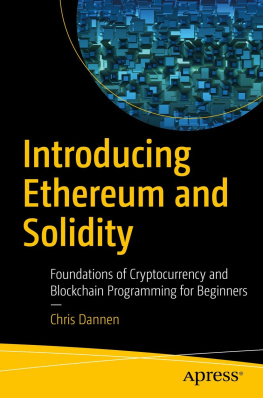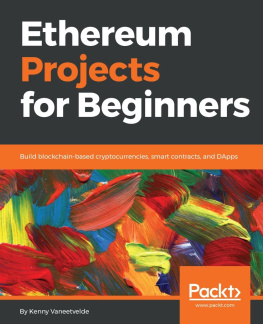1. Bridging the Blockchain Knowledge Gap
Acclimating to the fast-moving blockchain world can be challenging. This book is your guide. Before we get started, lets define some of the terms youll encounter ahead
A blockchain is a fully-distributed, peer-to-peer software network which makes use of cryptography to securely host applications, store data, and easily transfer digital instruments of value that represent real-world money. Cryptography is the art of communication via coded messages. In Bitcoin and Ethereum, cryptography is used to conjur one secure computing environment out of thousands of similar machines, running with no central authority and no single owner. With that kind of potential, its obvious why the technology has been subject to unprecedented speculation, hype, confusion, and prognostication.
The term Ethereum can be used refer to three distinct things: the Ethereum protocol, the Ethereum network created by computers using the protocol, and the Ethereum project funding development of the aforementioned two. On the heels of Bitcoin, Ethereum has become its own macrocosm, attracting enthusiasts and engineers from numerous industries. Many of civilizations most nagging imperfections could become the domain of blockchains killer apps, and the Ethereum protocol (which was derived from Bitcoin, and extended) is widely considered to be the network where these distributed apps will spring up. For developers, designers, and product managers, theres no better time to begin prototyping applications for the Ethereum network.
Blockchain Roll Call!
Two big groups of thinkers are interested in blockchain systems, and Ethereum more specifically: application developers interested in building products and services, and nonprogrammers who are curious about the potential of Ethereum, perhaps owing to work or interest in financial services, consulting, insurance, law, game creation, government, logistics, product design, or IT. This book is similarly cross-disciplinary. It provides a contextual guide for programmers and non-programmers alike to develop ideas about what to build, and how to build it. It fills a gap between computer science, economics, financial services, and where necessary, banking history.
For programmers, the challenging thing about Ethereum isnt usually the code; like most open source software projects, this one has on-ramps for people who already program in other environments. Rather, the challenge is wrapping your head around the concept of cryptoeconomics, or the system of incentives and disincentives which secure the network.
For nonprogrammers, the challenge is divining how the ecosystem will develop, and how you fit in. Claims that blockchains will modernize the banking system, revolutionize insurance, and lay waste to counterfeiting may be overblownbut by how much?
What Ethereum Does
In the abstract, open source blockchain networks such as Ethereum and Bitcoin are kits that allow you to pop up an economic system in software, complete with account management and a native unit of exchange to pass between accounts. Kind of like the game Monopoly . People call these native units of exchange coins , tokens , or cryptocurrencies , but theyre no different from tokens in any other system: theyre a form of money (or scrip ) that is usable only within that system.
Blockchains work something like mesh networks or local area networks (LANs); they are merely connected to other peer computers running the same software. When you want to make one of these peer-to-peer (P2P) networks accessible through a web browser, you need to use special software libraries such as Web3.js to connect an applications front end (the GUI you see in a browser), via JavaScript APIs, to its back end (the blockchain).
In Ethereum, you can take this concept one step further by easily writing financial contracts with other users inside the system. As youll see, these financial contracts are called smart contracts .
The key component is this idea of a Turing-complete blockchain. As a data structure, it works kind of the same way that Bitcoin works, except the difference in Ethereum is, it has this built-in programming language.
Vitalik Buterin, inventor of Ethereum
In Ethereum, smart contracts are written in the programming language Solidity, which youll learn about in Chapter . Turing completeness was an advantage that many developers quickly latched onto, but more important is Ethereums ability to save state. In computing, a simple definition of a stateful system is one that can detect changes to information and remember them over time.
Imagine a computer with no hard drive; you couldnt do much with it. It would be like a calculator, the contents of its memory fleeting. The ability to engineer interactions between users in the future, and under certain conditions, is a powerful addition to a blockchain. It allows developers to introduce control flow into cryptocurrency transaction programming. This is the biggest distinction between Ethereum and Bitcoin, but not the only one, as youll see.
Note
Control flow refers to the order in which computing instructions are executed or evaluated. Examples are conditional statements (if this, then that) and loops (which run repeatedly until certain conditions are met).
In Bitcoin , all transactions happen as soon as possible. Because of Bitcoins lack of statefulness, it has to execute transactions all in one go. The blockchain as envisioned by Bitcoins creator(s) was a distributed transaction ledger that kept a running tally of everyones bitcoin balances in the network. (A stylistic note for close readers: Bitcoin the network is written in the uppercase, and bitcoin the token in lowercase.) In Ethereum, a similar system is made extensible in a standardized way.
Secondarily, this common scripting language makes it more straightforward for blockchains that share the Ethereum protocol to share data with one another, enabling groups that use separate blockchains to share information and value with each other.
What is a Protocol?
If youre new to software development, a 10-second crash course in information technology (IT) will be useful here. IT can be defined as the study of computer systems to store, edit, retrieve, and send information. How that information is represented and updated over time, to reflect changes internal and external, depends on which technological system is in use.
In a telecommunications context, a protocol is a system of rules that describes how a computer (and its programmer) can connect to, participate in, and transmit information over a system or network. These instructions define code syntax and semantics that the system expects. Protocols can involve hardware, software, and plain-language instructions. No special hardware is needed for Ethereum, and the software is entirely free.
In Ethereum, the protocol is designed for building decentralized applications, with emphasis on rapid development time, security, and interactivity.
Three Parts of a Blockchain
A blockchain can be thought of as a database that is distributed, or duplicated, across many computers. The innovation represented by the word blockchain is the specific ability of this network database to reconcile the order of transactions, even when a few nodes on the network receive transactions in various order.
This usually happens because of network latency due to physical distance; for example, a transaction created by a user buying a hot dog in Tokyo will be dispatched first to nodes in Japan. By the time a node in New York gets word of this transaction a few milliseconds later, a nearby transaction in Brooklyn sneaks in ahead of the one in Tokyo. These inconsistencies due to subjective perspective in distributed systems is what makes them a challenge to scale. The power of blockchain systems is that they represent a combination of technologies we can deploy to crack the problem.








![Chris Dannen [Chris Dannen] - Introducing Ethereum and Solidity: Foundations of Cryptocurrency and Blockchain Programming for Beginners](/uploads/posts/book/119690/thumbs/chris-dannen-chris-dannen-introducing-ethereum.jpg)
![Fatima Castiglione Maldonado [Fatima Castiglione Maldonado] - Introduction to Blockchain and Ethereum](/uploads/posts/book/119687/thumbs/fatima-castiglione-maldonado-fatima-castiglione.jpg)